- Palace no more
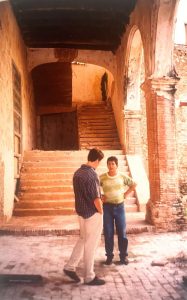 Read more
Read moreUntil the late nineteenth century, few Cuban sugar barons could challenge the Iznaga clan’s fortune, nor the family’s legendary propensity to spend it on exorbitant decorations and lavish furnishings of the highest quality and design, mostly acquired in Europe. Their ...
- Not your average congrí
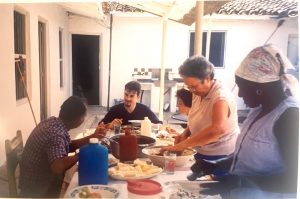 Read more
Read moreMost fans of the Cuban cuisine that South Florida’s restaurants serve know the staple of rice cooked with black beans— and onions, garlic, cumin, and herbs as moros y cristianos . Apparently established when Cuban exile cooks from ...
- “Cuban horse-drawn taxi”
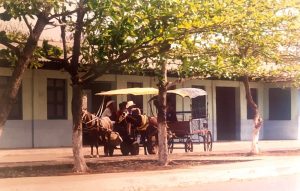 Read more
Read moreIn Havana, the return of horse-drawn buggies accompanied the rise in tourism as the primary source of income for the Cuban state: bouncing around on the back of a fancy one in Old Havana cost up to $25 for less ...
- “La Popa”
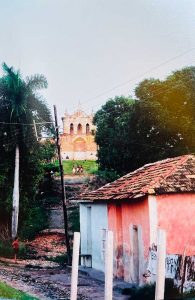 Read more
Read moreBuilt in 1716, the baroque façade of the Shrine of the Virgen of Candelaria and its location at the top of a hill overlooking the ancient town of Trinidad de Cuba bears witness to its once majestic past. Permanently closed ...
- “Its love chose me” [Su amor me escogió a mí]
![“Its love chose me” [Su amor me escogió a mí]](https://cubanstudies.history.ufl.edu/wp-content/uploads/sites/173/1Hawk-Lady-2001-1-212x300.jpg) Read more
Read moreIn the summer of 2001, my students and I stopped near the town of Cruces to tour the ruins of El Ingenio Santa Catalina, a nineteenth-century sugar plantation. At the height of slavery, its managers famously used homing pigeons to ...
- The Saga of Elián González in Cuba
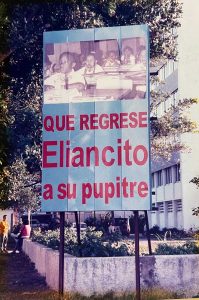 Read more
Read moreFrom November 1999 until June 2000, the story of five-year-old Elián was inescapable news in the United States. Rescued by fishermen from an innertube on Thanksgiving Day after his mother died while fleeing Cuba, the boy became the focal point ...
- Signs of the Times
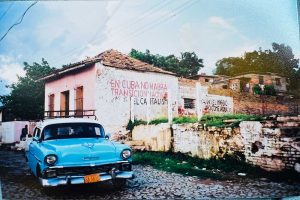 Read more
Read morePrior to the 1990s, triumphalism characterized most Cuban state propaganda. Self-congratulatory statements and predictions of Communist victories once universally pocked the landscape. However, after billions of dollars in annual aid disappeared along with the Soviet Union, messages on billboards and ...
- “The Phoenix”
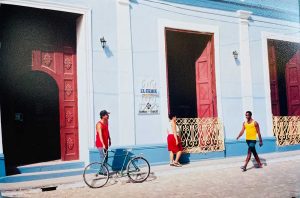 Read more
Read moreIn 1961, the Cuban government took over and expropriated the property of all Black mutual aid societies and social clubs, despite the critical role they played in representing the interests, history, and outlook of Black Cubans independently of white structures ...
- Door to the past and present
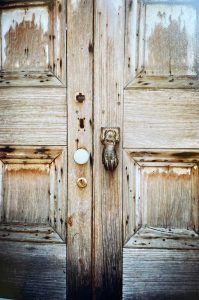 Read more
Read moreAs residents of a UNESCO World Heritage Site, trinitarios were able to remain in their homes rather than face forced relocation to settlements on the edge of the city as thousands of residents of Old Havana endured in the 1990s. ...
- Historians in action
 Read more
Read moreFor a little more than a month in the summer of 2001, I traveled to the Colonial Archive of Trinidad with Dr. Marial Iglesias Utset, now of Harvard University and then a professor at the University of Havana’s Department of ...
- WOMEN’S WEAVING COOPERATIVE
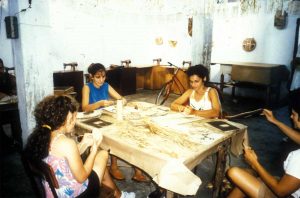 Read more
Read moreIn the early 1990s, many Cubans held out hope that small-time, artisanal businesses and state cooperatives like this one might thrive under the double barrier to neoliberal capitalism that the Cuban Communist Party’s monopoly on economic control and the ...
- HOMEGROWN COFFEE READY TO TOAST
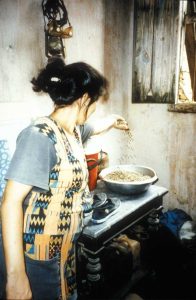 Read more
Read moreUnlike most coffee consumed in Cuba since the 1960s, this coffee is 100% pure because it was homegrown by peasants who then roast it for bartering and personal use. So if there is great, homegrown coffee in Cuba, why is ...
- CYCLING TOURS FOR FOREIGNERS
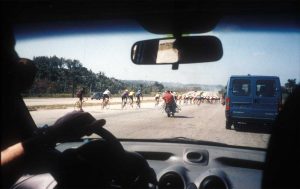 Read more
Read moreCuba’s dependence on Soviet oil and mostly Soviet-built parts for public transportation vehicles meant that the public transportation on which citizens relied to get to work, school, home or virtually anywhere ground to a near halt from 1991-2000. The state ...
- CARNICERÍA CANTÓN
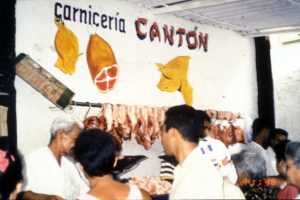 Read more
Read moreOwned by the state but supplied by individual farmers and newly legalized autonomous farming cooperatives, this butcher’s stand was always mobbed despite its limited selection (pork) and hours of operation (mainly Saturday mornings). The disappearance of already limited “proteins” in ...
- “24-HOUR SERVICE”
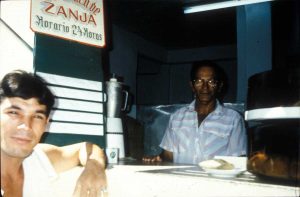 Read more
Read moreWhen the Cuban government legalized self-employment and small-time entrepreneurial businesses in 1992, Cubans who had once owned drink and snack stands prior to their criminalization in 1968 were suddenly back in business! Located in Havana’s Barrio Chino, this gentleman’s batido ...
- Barbero [The Barber]:
![Barbero [The Barber]:](https://cubanstudies.history.ufl.edu/wp-content/uploads/sites/173/9.-Barbero-199x300.jpg) Read more
Read moreIn March 1968, Fidel Castro unexpectedly announced that the Cuban state would shutter and confiscate all remaining 52,000 small businesses in a policy maneuver he called La Ofensiva Revolucionaria . He also announced that they would re-open—supposedly as ...
- The Colonial Williamsburg of Cuba?
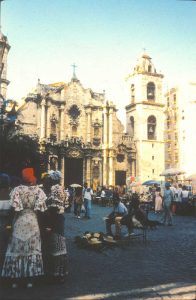 Read more
Read moreAs rumor had it, Eusebio Leal, director of the Office of the Historian of Havana, modeled his efforts to revitalize public spaces in Old Havana on the practices of Colonial Williamsburg From the series, “Special Period in a ...
- Panataxi:
 Read more
Read moreWhen the Cuban state authorized self-employment in 1993 for the first time since 1968, it also created a dual currency system which, theoretically, was to ensure that hard currency (the US dollar) flowed from the hands of foreigners, especially tourists, ...
- “Nothing as slow as El Rápido”:
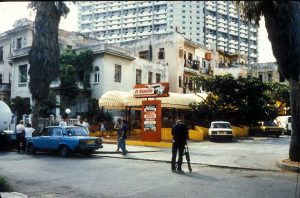 Read more
Read moreIn apparent effort to compete with foreign standards for providing cheap fastfood, the Cuban government opened a state-owned chain of small restaurants called El Rápido . To no-one’s surprise, service was slow, servings of French fries were always ...
- American college students discover Communist romance novels:
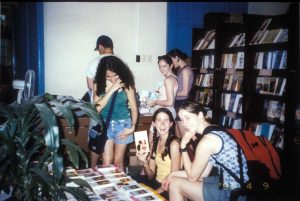 Read more
Read moreIn the late Special Period, Cuban bookstores still sold the ideologically curated works of the “High Soviet” years. As my students soon discovered, this meant mostly the collected works of Lenin, Engels, and Martí along with countless editions of Don ...
- American sailboat moored off Cayo Blanco:
 Read more
Read moreAs I often discovered, the highly restrictive laws of the United States’ Office of Foreign Assets Control governing the US Embargo and US citizens’ spending in Cuba rarely seemed to apply to wealthy Americans. This might be especially true of ...
- The rise of Santería:
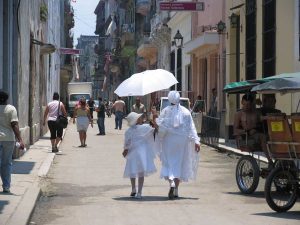 Read more
Read moreOnce the reserve of the literate and privileged few of colonial Havana, writing and mailing letters abroad was both a national past time for the elite and stamp of progress (no pun intended). From the series, “Special Period ...
- View from the porch of the Museo Romántico:
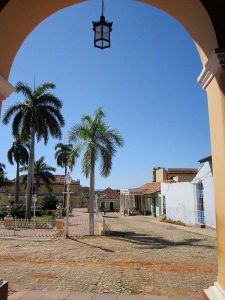 Read more
Read moreBuilt in the 1740s and owned by the German-Cuban Brunet family, this mansion’s positioning at the very heart of Trinidad’s sixteenth-century central town plaza speaks to the vast wealth that the Brunets garnered from sugar plantations and the hundreds of ...
- Museo Nacional de la Lucha Contra Bandidos:
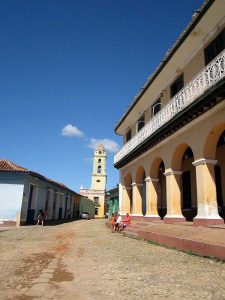 Read more
Read moreLocated in the former convent of St. Francis of Assisi and marked by a large colonial bell tower, this museum in the colonial town of Trinidad memorializes the Communist regime’s six-year repression of peasant uprisings in El Escambray, the country’s ...
- Colonial Mailbox in Old Havana
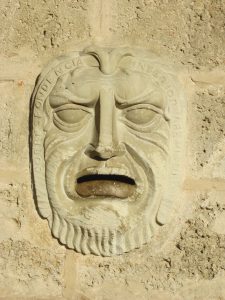 Read more
Read moreOnce the reserve of the literate and privileged few of colonial Havana, writing and mailing letters abroad was both a national past time for the elite and stamp of progress (no pun intended). From the series, “Special Period ...
- Playing mambí
 Read more
Read moreWith a newly made toy machete that his grandpa Tiki fashioned from some refuse wood, little Daniel pretends to be a mambí, one of the tens of thousands of nineteenth-century independence fighters drawn from the poorest ranks of peasants and ...
- Valle de los Viñales
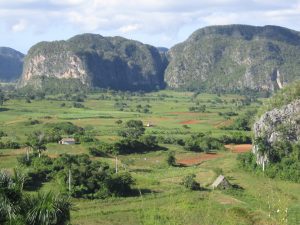 Read more
Read moreOne of the many wonders of Pinar del Río’s lush landscapes, the “Valley of the Vineyards” has no vineyards anymore, if it ever did. Early Spanish conquistadors supposedly grew grapes for their sacramental wine in this valley during the 1500s ...
- Wildlife, Not Cars, on Cuban Highways
 Read more
Read moreOne reason most foreigners who visit Cuba love the country relates to the absence of traffic, of noise from traffic and—with the singular exception of Havana—of the pollution that thousands of old cars and government trucks (most still lacking catalytic ...
- “Viva Fidel”: Censoring Censorship
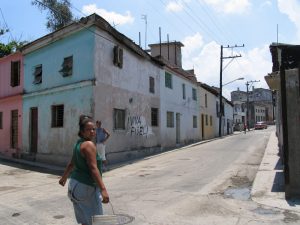 Read more
Read moreThe day before Fidel Castro’s birthday every August 13th, legend had it that Cubans lost their fear and carried out minor acts of protest and sabotage in the middle of the night. As I later documented in the introduction to ...
- Appropriating Cuba’s 19th Century Past
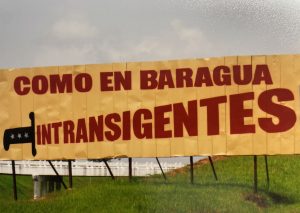 Read more
Read moreThe coincidence of the collapse of the Soviet Union with the centennial anniversary of Cuba’s last war for independence in the 1890s could have been disastrous for the Communist regime: after all, Fidel had contended since his pre-dawn victory speech ...